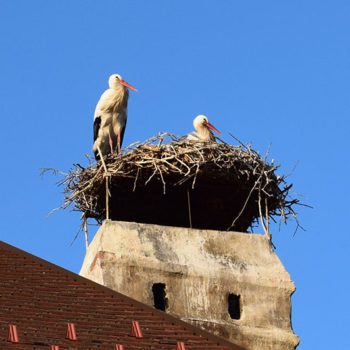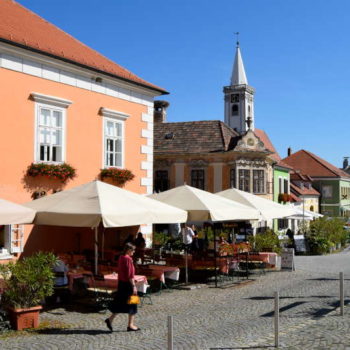The small historic town of Rust is beautifully situated on the western shore of Lake Neusiedl, in northern Burgenland, not far from the Hungarian border.
We visited the small town on a “hot summer day” in mid-September and enjoyed lovely walks, good food and a boat trip on Lake Neusiedl. Rust’s historic centre offers many well-preserved historic buildings and is still partly surrounded by a medieval town wall. Rust is now on the list of World Cultural and Natural Heritage Sites.
Historic Rust
Although there had been settlements in the area during both the Celtic and Roman periods, Rust was put on the map when a moat and town wall was built in 1512. Unfortunately, this didn’t help much, as the Turks (Ottomans) took the town in 1529 and 1532. The ring wall that you can partly see today dates from 1614. The cityscape today is characterised by the numerous houses built between the 16th and 19th centuries, with well-preserved Renaissance, Baroque or historical facades that include beautiful window and portal frames, bay windows, coats of arms and stucco decorations.
Fisherman’s Church
If we highlight one of the historic buildings in Rust in particular, it has to be the Fischerkirche (Fisherman’s Church) that you see on the hill above the main square (Rathausplatz), just in front of a more modern church. This is the city’s oldest standing structure, and the oldest parts date back to the 13th century. Today, a museum in the former Roman Catholic church, that was built on top of a Roman watchtower. It costs EUR 2 to enter and is well worth the money to see the frescoes, among other things.
The city of Storks
You can’t walk around Rust without noticing the rooftop bird nests. This beautiful large bird has made the small town of Rust one of its favourite nesting sites along Lake Neusiedl. Rust is currently home to 22 pairs of storks, but when we visited in September, they had all flown to more southerly latitudes, and the nests were empty. However, storks were in all the nests on a spring visit, and it was easy to admire these beautiful birds.
ADVERTISEMENT
Local wines
Traditional and indigenous viticulture utilises the unique microclimate of Lake Neusiedl and the vineyards’ different soil structures and altitudes to produce excellent wines. Today, it is primarily the vineyards that attract visitors, as well as bathing and boating tourism. The surrounding landscape is characterised by vines belonging to various vineyards, many of which are located in Rust itself. Therefore, especially in autumn, you can see a lot of traffic with tractors bringing in the year’s crop of grapes. Several vineyards (look out for Weingut signs) have beautiful restaurants in their backyards, and many offer both tastings and wine sales almost year round.
Boat trip on Lake Neusiedl
On a hot summer’s day, in this case with 28 °C, we opted to get out on the lake by boat. From the Stadthafen (Town port) just outside the city and the marina at Ruster Bucht, you can board sightseeing boats or cycle ferries to Lake Neusiedl. We joined Drescher Line for a one and a half hour cruise on the Lake Neusiedler See. From the boat you’ll better understand the landscape surrounding the 36 km long and 12 km wide lake. From the boat you can see how this part of Austria differs from Alpine country further to the west. It’s entirely flat to the east and in the west there are som hills at the horizon, making the region completely different from the rest of the country.













